Here’s the results of last year’s experiments wintering over plants, which I wrote about in this post. I’m listing each plant in the same order as in that first post. Under each plant, I’m putting a few of my remarks from last year in italics, just to give some context. You’ll find out which plants survived the winter in my basement, and which I think are worth the time and space to winter over again. Ready?
What I did and why
Agapanthus (aka Lily of the Nile) ‘Storm Cloud’ I received a pretty small plant in the mail, and it didn’t bloom this year[2018]. My goal this summer was to enable it to build up size and strength so that it would bloom in 2019.
‘Storm Cloud’ finally sent up two flower stalks, but by the time they opened up I had already brought the pot in because of frost, and they bloomed indoors in the second half of October.
Why didn’t it bloom sooner? Did it need more heat? It has to be content with what my cold climate considers “summer” or it will need to find a new home. I will give it one more year, just in case it needs a bit more maturity. In the meantime, I’m on the lookout for ‘Blue Yonder’ agapanthus, which is considered hardy to USDA zone 5 “with protection.” I would love to be able to plant agapanthus in the ground, but even if it remained in a pot, I would think a hardier selection would bloom sooner.
Angelonia Supposedly angelonia can be overwintered as a dormant plant. Mine did not. It’s possible I should have repotted them a couple of weeks before I cut them back and put them in the basement. I probably won’t try to overwinter them again.
Begonia I bought tuberous begonias for the Garden Shelter. Alas, only one tuber of the six survived winter in my basement. That one tuber will be wintered over again this year, but I’m trying a different plant for the Garden Shelter hanging baskets (see below).
Canna Tropicanna Gold. I dig them up, shake off as much dirt as I can, and put them in a plastic garbage bag. I grew all my cannas in pots this year, and I decided to just leave them in those pots for the winter. As usual, I waited until they got frosted, and then cut back all the dead foliage before bringing them in.
Coleus (Solenostemon varieties) Last year I saved the one coleus that my husband really loved. This year I rooted cuttings of that same plant, which are now potted up, and also brought in one plant growing well in a container. As the sunlight gets weaker and weaker, I expect this big plant to decline, at which point it will go on the compost pile. I also got cuttings of some other varieties from a friend, which are also now potted up and lined up along windowsills.
Dahlia I used to grow dahlias in pots because I knew I wanted to bring them into the basement for the winter. But dahlias grow bigger and better when planted in the ground, especially in well-amended soil. To winter them over, I put them in cardboard boxes, making sure to label the variety on the box, and store them in the coolest part of the basement. The hardest part is finding a big enough box, because the clumps can get really big, and I like to plant them big in the spring, so I don’t want to divide them. I wait for a killing frost before digging them.
This past winter, some tubers dried out, more than in previous years. I decided to try this method of growing dahlias, which involves keeping the tuber in a small container, and planting it–container and all–into the ground or into a larger container. Then, instead of digging tubers up, you remove the small container, leaving the tuber in it and replanting it–still in that small container–next year.
This method appeals to me because storing them goes more quickly in the fall, waking them up is less bother in the spring, and it is similar to what I used to do at my previous garden. However, I’m not sure gallon-size pots are the way to go. At least two of the dahlias in pots had made tubers outside of the pot, through the drainage holes in the small container.
I yanked the first pot out of the ground, not realizing some of the dahlias might do this, and broke off the tuber that was sticking out of the pot. After that, I removed the pots more carefully. I will probably have to cut the pot pictured above apart to successfully remove the dahlia and repot it in a wider, shallower container next spring.
My dahlias didn’t seem to do as well as in previous years. Many of my local gardening friends had the same experience–the dahlias bloomed late, and didn’t grow as vigorously as expected. I’m not going to blame the container method yet, but I will try to be more diligent about watering and feeding them. The only stupendous dahlias I had this year were growing in the compost pile. I had thought the tubers were duds and tossed them.
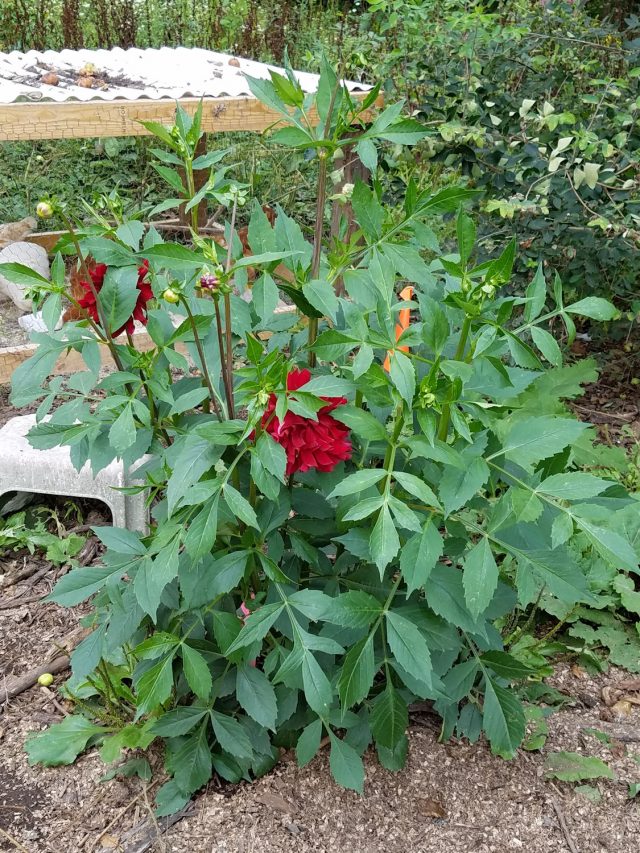
The dahlia growing in the compost pile was more vigorous than any I grew in the garden, but it still started blooming pretty late. It’s just starting to bloom at the end of August.
Eucomis (aka Pineapple Lily) Hopefully they will grow to blooming size next year. Eventually I want to try some in the ground. They did grow to blooming size, and I planted two in the ground this fall and kept two in a pot, which is now in the basement.
Four O’Clocks (Mirabilis jalapa) ‘Limelight’. I decided to dig it up and save the tuber, just like I used to do with Mirabilis longiflora. It didn’t resprout from the tuber.
Geranium (As in Pelargonium the bedding plant geranium that we treat as an annual, but is actually a tender perennial.) If they make it through the winter I can take more cuttings to grow next spring. Many other sources say to let them dry out and go dormant, and revive them in the spring. I’m trying both. The dried, bareroot ones didn’t live. All the cuttings lived, but they much preferred a windowsill upstairs to the grow lights in the basement. I don’t have room for all of them at windowsills, so I will rotate them this winter. The basement area stays around 55°F (13°C), and that may be too cold for them (and, ironically, too warm for the dormant tubers).

The geraniums and sweet potato vines worked well in the carriage barn windowboxes, so I’m wintering over both these plants again.
Gladiolus They’re down in the basement with the rest of the stash. I didn’t dig any glads this fall; I left them all in the ground. The glads planted several years ago in the vegetable garden have come back consistently, so I decided to take my chances with the deep red ones planted in the front.
Hibiscus Jolly Polly tropical hibiscus Some grow it as a houseplant, and others let it go dry and dormant. This plant is tied with the agapanthus for being most aggravating. It only produced one flower, which didn’t bloom until it was brought back inside. I think I’m going to induce dormancy this winter, as I really don’t feel like it’s earned a spot by a window.
Jewels of Opar (Talinum paniculatum ‘Kingwood Gold’) I’ve dug the tubers and stored them in a paper bag in the basement. None of the tubers lived and the seeds encountered an unfortunate event before they even sprouted. No ‘Kingwood Gold’ this year, but a friend sent me fresh seed so I will try again next year.
Rain Lilies (Zephyranthes) Mine are still in their pot in the dark part of the basement with the other stored plants and still have green leaves on them. I don’t know what it’s going to take for them to dry out and go dormant. I’ll bring the pot back out in the spring. Once again, they didn’t bloom much. Not sure if I’m doing something wrong or they need to get more potbound. Also don’t know if I should be doing something more to induce dormancy.
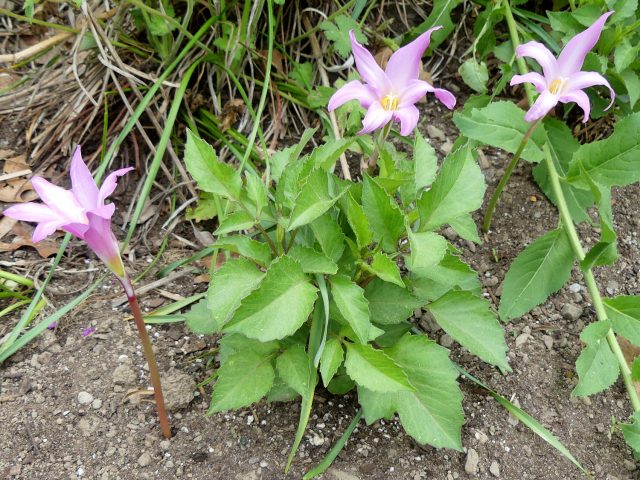
I grew rain lilies in the garden before I learned they could be wintered over in a pot. (Those are dahlia leaves; the rain lilies bloom without foliage.)
Rosemary (Rosmarinus officinalis) I winter over a rosemary every year, and I wrote about it here. We’ve moved to a new house since I wrote that post, and I finally did get a ‘Salem’ rosemary. It’s in the cool room above the attached garage in a south-facing window, where I’ve successfully overwintered it in previous years.
Salvia There are lots of tender salvias and the advice is to “take cuttings to keep them going.” The cuttings made it to spring but they weren’t especially floriferous plants this past summer, so I decided not to take cuttings again. I need the space for plants I like better.
‘Lemon Coral’ Sedum (Sedum mexicanum) I love this plant. It mixes so well with other plants in a container, but it’s not hardy here. It was a trial plant sent to me by Proven Winners, and they say it does well as a houseplant. I’m keeping a pot through the winter again. It’s worth the windowsill space.
Golden Sweet Potato Vine (Ipomoea batatas) I replanted two in a hanging basket and I’m growing them as a houseplant. I harvested the tubers for the other two, tossed them in a paper bag and they’re in the basement with all the rest. The tubers didn’t live. But I rooted cuttings in water from my mother plants and potted those up as a houseplant for the winter. I’ll root cuttings again in early spring to have enough for every window box.
New additions to the experiment
Diamond Snow™ euphorbia – This was a trial plant that I liked very much. My mom had been given a similar plant (probably Diamond Frost™) after surgery and has been growing it as a houseplant, so I decided to try the same with mine. I wound up breaking a lot of stems as I dug it out of the big container to transfer it to a pot of its own, but it seems to have recovered. You can see it in the topmost image on the left.
Macho fern (Nephrolepis biserrata) I bought two of these for the Garden Shelter hanging baskets. They are now hanging up in the house, but I don’t think they are getting enough light and I’m sure the air is too dry. I’ve read that dormancy can be induced in Boston fern, and this is a relative, so I’m wondering if I should try that. It involves putting it in a dark, 50°F spot–but you still need to water it once a month. I might not remember.
Voodoo lily (Amorphophallus conjac) I acquired this at a plant sale and it’s not hardy here, so into the basement it goes. This voodoo lily goes dormant before frost arrives. I left it in its pot and put it with everything else in the darkest part of the basement.
Voodoo lily (Sauromatum venosum) Yes, I have two different plants whose common name is voodoo lily. This one needed to experience frost before it went dormant. I cut off the shriveled stem and put it, pot and all, in the basement.
About that basement I keep mentioning

The potted dahlias are stored in the crates. Various other bulbs and roots are clustered around them. The white rectangle leaning against the green pot is the temperature sensor which sends data to my weather station. That’s how I know it’s not as cold as it should be.
My basement is neither as cold or as dark as recommended. Since we had our heating system renovated, our basement temps hover around 55°F (~13°C), when 40°F (~4°C) is most commonly recommended. We actually have a lot going on in our basement: a seed-starting set-up with lights, a washer and dryer, a pantry, a second stove, and two freezers–and a large household that uses them all. Not everyone who goes down there remembers to turn the light off when they come back up, so it’s not always as dark as dormant plants would like. I did box and crate everything and stuck it all in the crawl space part, so my plants are in the darkest and coolest location, but it’s not ideal. But that’s part of the experiment, to see what works for me in my not-ideal conditions. I hope it inspires you to do some experimenting of your own!



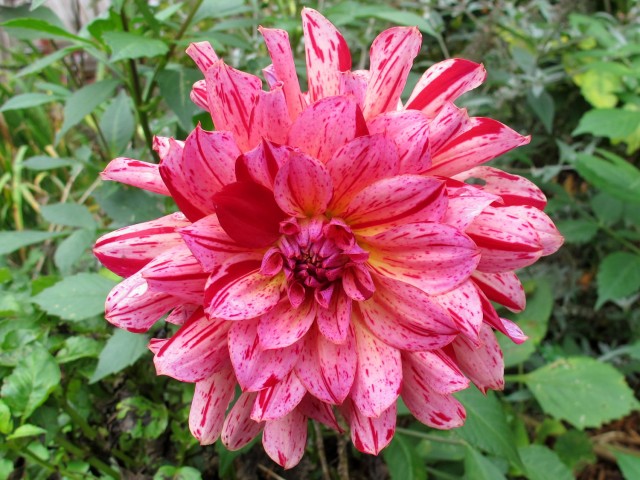

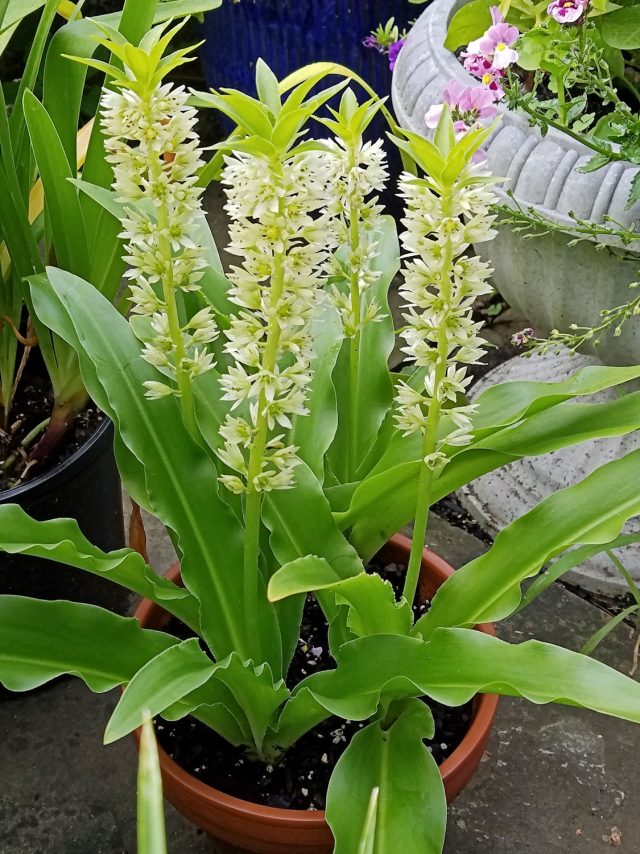
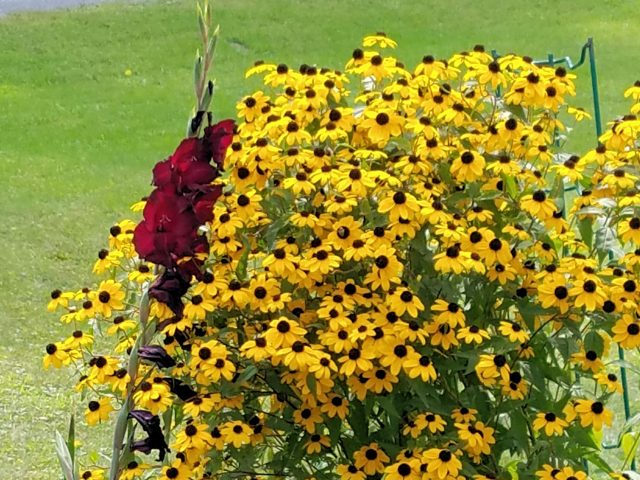

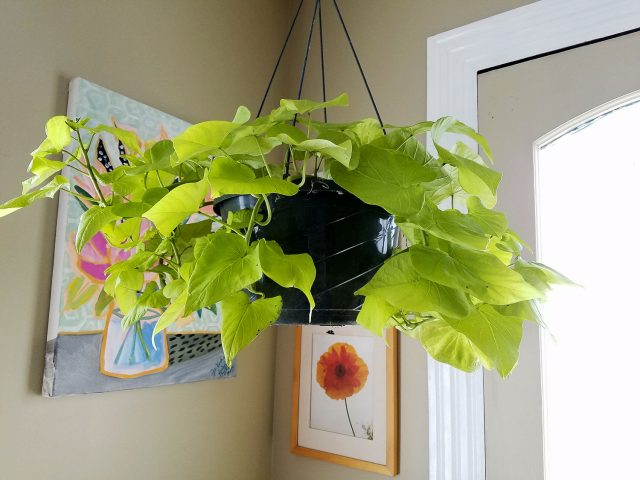

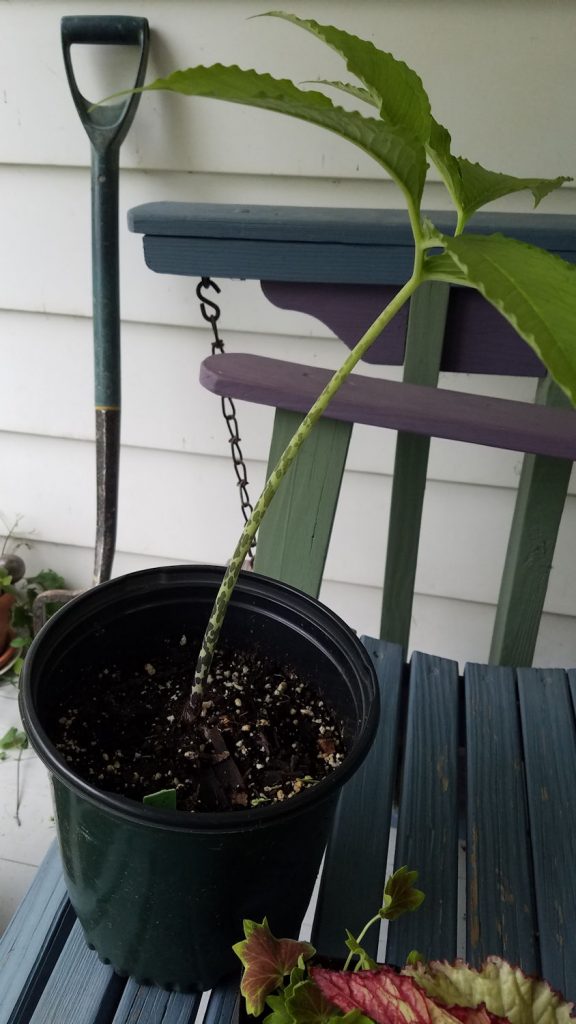



Thanks a lot, Kathy, for this article – I stumbled across it when I was on the search for some advice on winter plantings for Agapanthus for a client of ours here in the UK. Winter has settled in over here so your recent experience has come at a perfect time. Thanks
I’m new to Dahlias, so I appreciate your tips! Last winter, I put them in peat moss in a bag; one variety survived just fine, the other didn’t produce. Thanks for sharing your experiences. I never thought to overwinter Angelonia–love it! I’ll have to try that, too. Great post!
Beth, check out Sterling’s comments on this post. He has even more dahlia tips!
I grow Agapanthus Storm Cloud and have wintered it over in Zone 5b for the past 3 winters. It blooms for me in July and attracts many hummers. I winter it over in my attached garage where it stays above freezing (almost all days) usually 35-45 degrees. Started with one plant and now I have 4 pots of it.
Stephen, thanks for letting me know. My basement doesn’t get that cold and I’m pretty sure my detached garage gets colder. But I’m going to try it anyway.
They say they’ll have it available in January…http://www.brentandbeckysbulbs.com/Agapanthus/Blue-Yonder/African-Lily
Thank you, Alan!
I live in SW Ohio, Zone 6a. I’ve been digging up and moving 30-50 dahlia plants inside during winters for about 10 years. Have tried various approaches, including storing in plastic or paper bags, storing in peat moss, and storing in vermiculite. Some years I dusted them with anti-fungal dust to try to prevent rot. Some years I washed them before storing, some years I left out a week after digging to dry. Some years most tubers were ok, some years dry, one year they rotted. Good results the last three years using this method: dug soon after 1st frost blackened plants, knocked loose dirt off tubers, cut off stringy roots from tubers, used sharp awl to poke a hole vertically through the remaining stem base so stem water drains out over time, did not wash, tied undivided clumps with their labels, put clumps in old styrofoam coolers filled with vermiculite, left lids of coolers partially ajar, stored coolers in cool room that is part of attached garage (temp no lower than 45 degrees). Many of my dinnerplate size dahlias form clumps that would not fit in 1-gallon containers. Vermiculite gives better results than storing in peat moss. No need to dust with anti-fungal powder. Had smaller dahlias in containers that I left in their dirt and brought in during winter also did fine, so I think the idea of leaving tubers undisturbed in container soil and overwintering inside works, but that is not practical for larger dahlias planted in ground. Lots of variables change every year so overwintering dahlias is a guessing game. Thanks for sharing. Incidentally, I was disappointed that except for one variety, dahlias seemed to start blooming much later this year. Learned later blooming was because of the high temps we had for most of summer, and that dahlias need some cool nights before they bloomed. After cool nights arrived, had nice blooms. (Our expanding crop of colchicums bloomed very nicely this year. Thanks again for being our colchicum advocate and resource!)
Sterling, thanks for these detailed comments. I knew I was saving those styrofoam chests for a reason! Now I need to invest in a quantity of vermiculite.
Thanks for a great review of overwintering plants. It is very helpful.
You’re welcome, Lee.
I take cuttings of coleus every year. They struggle through the winter but then come back beautifully in my planters in the spring. I’ve overwintered my special maple leaf geranium in the pot for years. It loses its red coloring but comes back beautifully once it gets more light outdoors. The Sauromatum venosum corms just go on the top of houseplant pots. They break dormancy with their stinky “flower” long before they can go outside which is how I find them in their long forgotten pot locations. I’ve had mixed results with the begonias but I leave them in the pots and wait until they break dormancy to start watering again. One you didn’t mention is elephant ears which I do grow, stored in a cool place in a dry medium; it is a very dramatic plant in the garden. I’ve grown most of the other non-hardies you mention but no longer because I lack the winter storage space, but fortunately do have an unheated room.
Thanks for the tip on Sauromatum. I will have to check if I smell “something dead” down in the basement. My understanding is a lot of the newer elephant ears don’t go dormant because of interbreeding.
Everything grows better in the compost pile! ha… I have some pet plants that I bring in during winter but I don’t do much over wintering of plants. If I had a basement or a sun room I would do more. Best of luck with your experiments. I like reading about them.
I’m glad you enjoy them, Lisa.